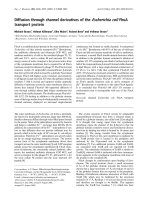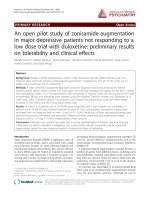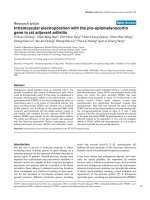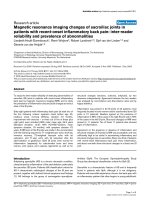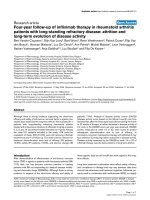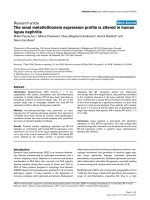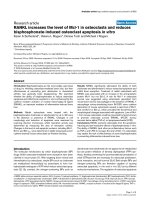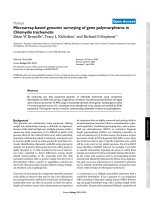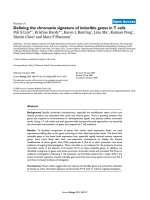Báo cáo y học: "hiropractic diagnosis and management of non-musculoskeletal conditions in children and adolescents" doc
Bạn đang xem bản rút gọn của tài liệu. Xem và tải ngay bản đầy đủ của tài liệu tại đây (229.79 KB, 8 trang )
REVIEW Open Access
Chiropractic diagnosis and management of
non-musculoskeletal conditions in children
and adolescents
Randy J Ferrance
1*
, Joyce Miller
2
Abstract
Background: A great deal has been published in the chiropr actic literature regarding the response, or lack thereof,
of various common pediatric conditions to chiropractic care. The majority of that literature is of low scientific value
(that is, case reports or case series). The purpose of this review is to summarize the literature from the point of
view of clinicians, rather than researchers, and to discuss some addit ional detail of the conditions themselves.
Methods: Databases searched were PubMed, Mantis, Index to Chiropractic Literature, and CINAHL. Keywo rds were
chiropractic paired with colic, crying infant, nocturnal enuresis, asthma, otitis media and attention deficit
hyperactivity disorder.
Results: Most of the published literature centers around case reports or series. The more scientifically rigorous
studies show conflicting results for colic and the crying infant, and there is little data to suggest improvement of
otitis media, asthma, nocturnal enuresis or attention deficit hyperactivity disorder.
Discussion: The efficacy of chiropractic care in the treatment of non-musculoskeletal disorders has yet to be
definitely proven or disproven, with the burden of proof still resting upon the chiropractic profession.
Background
While most patients presenting to a chiropractor’s prac-
tice for care do so for musculoskeletal complaints, the
National Center for Hea lth Statistics found that in the
United States, attention deficit hyperactivity disorder,
sleep problems, asthma and sinusitis were also frequent
complaints for which parents sought complementary
and alternative medicine (CAM) for their children [1].
Children who are taken to a CAM practitioner tend to
have underlying chronic medical problems and take
medication on an ongoing basis, and chiropractors are
the most common CAM providers visited by children
and adolescents [2]. A recent systematic review found
that chiropractors treat a wide variety of pediatric health
conditions, but that those interventions are supported
by only low levels of scientific evidence, most of which
is clinical experience, descriptive case studies and very
few observational and experimental studies [3]. While
by no means comprehensive, t his paper aims to list the
conditions for which a child or adolescent patient might
present for care in the hope of summarizing the cur-
rently available diagnostic criteria and evidence for
chiropractic treatment.
Review: Common Pediatric Conditions
The Crying Infant
The excessively crying infant has been an enigmatic
condition since it was first described by Spock in 1944
[4]. It continues to be the most common cause for med-
ical consultation for infants under 16 weeks of age [5,6].
Multiple types of therapies have been proposed but few
have withstood the rigors of scientific study. Conven-
tional medicine has provided no a nswer to the problem
of infant colic [7]. No medical treatments have been
found to be effective except the medication, dicyclo-
mine, which reduced crying in 63% of infants but was
accompanied by side effects of apnea, seizures and coma
and this treatment is now considered to be contraindi-
cated in infants under six months of age [8].
* Correspondence:
1
Hospitalist and Medical Director of Hospital-Based Quality, Riverside
Tappahannock Hospital, Tappahannock, VA, USA
Ferrance and Miller Chiropractic & Osteopathy 2010, 18:14
/>© 2010 Ferrance and Miller; licensee BioMed Central Ltd. This is an Open Access article distributed under the terms of the Creative
Commons Attribution License ( which permits unrestricted use, distribution, and
reproduction in any medium, provided the original work is properly cited.
Chiropractors have long claimed to provide an effec-
tive treatment for infant colic. In fact, a Best Evidence
Report published in 2002 in the prestigious journal,
Arc hives of Disease in Child hood, makes the stat ement,
“There is good evidence that taking a colicky infant to a
chiropractor will result in fewer reported hours of colic
by parents [9].” However, it is not known whether the
reduced crying is due to the specific therapy or because
of the social setting surrounding the situation of taking
a colicky baby to a unique practitioner [10]. There are
two studies ongoing at this time in the UK and Den-
mark that will attempt to answer this question [7].
Meanwhile, we are left with the studies that have been
done to test the efficacy of care for i nfant colic. Table 1
shows the studie s that have been done in manual ther-
apy with individual study results [11-15]. Most trials
were poorly designed and poorly executed. If we are to
find an effective treatment for infan t colic, research
must be improved to a threshold to be able to identify a
worthy treatment, if it exists. Of importance in review-
ing the risk/benefit ratios of available therapies, there
were no adverse side effects in a ny of the manual ther-
apy trials. Manual therapy may not have been proven to
be effective, but it does appear to be safe [11-17].
The trials that demonstrate effectiveness for manual
therapy have significant weaknesses. Mercer and Nook,
who presented their work at the 1999 World Federation
of Chiropractic Conference failed to show clear methods
of randomization and did not use the gold standard out-
comes measure of the crying diary. It should be noted
that this study has never b een published in a peer
review journal.
Wiberg et al (199 9) found that chiropractic manipula-
tion was effective in relieving infant coli c. They used
crying diaries and randomization; howev er parents were
not blinded to the therapy received by the baby. This
study was classified as “ high quality” by Hawk et al
using Jadad scor ing as was the Olafsdottir et al (2001)
study [18]. Olfasdottir et al in their randomized con-
trolled trial found that chiropractic spinal manipulation
was no better than placebo in the treatment of infant
colic. In this study the investigators did not use a crying
diary as an outcome measure, but instead asked the par-
ent whether or not the child had improved and how
much. This study has been criticized because it adminis-
tered a maximum of three treatments whereas other
trials used a more pragmatic approach prescribing the
number of treatments the chiropractor found to be indi-
cated within a 14 day time period. However, when com-
paring the Wiberg and Olafsdottir studies there was
ver y little difference in the mean number of visits given
(3 versus 3.8). The Olafsdottir trial was shorter with a
maximum of eight days intervention. Nevertheless, the
Olafsdottir study showed no significant difference in
recovery between the group of infants that received
pediatric manipulative therapy versus those who were
Table 1 Summary of infant colic and manual therapy RCTs
Authors N Age and treatment
numbers, type of treatment
Instrument Therapy/Control SSD Level of
evidence
Mercer and
Nook
30 0 to 8 weeks of age;
maximum of 6 treatments in
2 weeks, manual therapy (MT)
Subjective parent report
questionnaires before
treatment and subsequent
visits
Chiropractic MT to spinal
fixations v control of non
functional detuned ultrasound
machine
yes C
Wiberg,
Nordsteen
and Nilsson
50 Treatment mean age 4.9;
control mean age 5.9; 3-5
treatments over 2 weeks;
manual therapy treatment
Validated crying diary Light pressure with the finger
tips v semithicone as control
yes C
Olafsdottir,
Forshei,
Fluge and
Markestad
100 3 to 9 wks of age, maximum
of 3 treatments over
maximum of 8 days;
Manual therapy treatment
Crying diary and questionnaire
at each visit. At the end of the
observation period, the parents
were contacted by telephone
and interviewed
Light fingertip pressure on
thoracic spine. Control infants
were held by the nurse for 10
minutes with light back
massage after being partially
undressed in a similar way as
treated infants
No; both groups
had a mean
reduction in
crying from 5.1-5.4
to 3.1 hours per
day
C
Koonin,
Karpelow-
sky,
Yelverton
and Brent-
Rubens
31 Treatment mean age 5.7
weeks;control mean age 5.9
wks; 6 treatments maximum
over 2 weeks; manual therapy
treatment
Pre, post and follow up
questionnaire
Chiropractic manual therapy
with allopathic medication v
allopathic medication alone
yes C
Hayden and
Mullinger
28 Treatment mean 6.6 weeks of
age, control mean age 6.4
weeks; 2-4 treatments of
manual therapy
Diary Cranial osteopathic manual
therapy v no treatment
yes C
SSD-statistically significant difference; N-number of patients; C-level of evidence defined by Bronfort 1997
Ferrance and Miller Chiropractic & Osteopathy 2010, 18:14
/>Page 2 of 8
held by the nurse with back massage. Koonin et al. did
not use randomization and all children were on medica-
tion so it was a s tudy of chiropractic care with medica-
tion versus treatment with medication only. This was a
pragmatic study and may demonstrate that realistically,
many infants who come for chiropractic care for infant
colic are already using a medication; 45% of those in a
crying study were taking medication when presenting to
a chiropractic teaching clinic [19]. Hayden and Mullin-
ger in an osteopathic study used an uncommon defini-
tionofcoliccryingofonly1.5hoursperday(colicis
usually defined as crying more than three hours per day
more than three days per week), demonstrated out-
comes w ith an unvalidated diary and did not use inten-
tion to t reat (ITT) analysis. None of the trials to date
stand up to the scrutiny of best-practice research. The
evidence is unconvincing that chiropractic care alone
can provide a quick and e ffective treatment for infant
colic.
One possible explanation as to why few interventions
have been found to effectively treat colicky crying may be
the failure to identify subgroups of crying babies.
Research studies have by and large failed to determine
whether the excessive crying stemmed from colic or from
another cause [20-23]. Many chiropractors may believe
that subgroups exist but have not engaged in any classifi-
cation system. Such a classification system or subgroup-
ing might be able to demonstrate improved clinical
outcomes. A prospective observational study reported i n
2009 [23] demonstrated improved outcomes relative to
the group when 158 infants were divided into three cate-
gories, infant colic (IC) (n = 77/158 or 49%), irritable
infant syndrome of musculoske letal origin (IISMO); n =
56/158 or 35%) and ine fficient feeding, c rying infants
with disordered sleep syndr ome (IFCIDS); n = 25/158 or
16%) according t o specific criteria (table 2). There were
no statistically significa nt differences in the demographic
profile of the three groups. Although the design of this
study cannot determine efficacy, this was the first study
of its type following babies presenting to a chiropractic
clinic for excessive crying having classified the infants
into three groups. Parents of excessively crying infants
demonstrating a musculoskeletal problem (IISMO)
reported most improvement, with colicky infants a close
second, but with IIFCIDS, a syndrome of unknown ori-
gin,parentsreportedlessimprovementandmore
ongoing stress (Table 3) [23]. If further studies can corro-
borate this or another meaningful subclassification for
the crying i nfant, better clinical outcomes may be
achieved as well as improving res earch studies. Inclusion
criteria aimed at homogenous groupings may be better
able to establish efficacy.
Until better s tudies can be designed and carried out,
health care practitioners are face d with the dilemma as
to what to recommend to parents of the excessively cry-
ing infant, a condition known to be quite dangerous to
someinfantsasitistheleadingcauseofinflictedor
non-accidental injury in the child [24-26]. A summary
of what is known may be useful. Taking a crying baby
to a chiropractor for treatment does result in fewer
hours of crying but this also seems to be the case with
placebo [14]. Nevertheless, there is also promise that the
parent may feel less anxiety and the infant may sleep
better and longer [20]. So, although controversial, we
conc lude that in cases where all other seriou s diagnoses
have been excluded and in the absence of any other effi-
cacious therapy as well as a favorable risk/benefit ratio,
it seems reasonable to us to send a colicky infant for a
therapeutic trial of 4-6 chiropractic treatments. Future
studies require blinding the parent and the assessor and
including a non-treatment control group (as in a waiting
list) to determine whether chiropractic manual therapy
for infant colic has more than mere promise.
Enuresis
Enuresis, or urinary incontinence in children, is a com-
mon problem, with a prevalence that ranges from 16%
at five years down to approximately 5% at 10 years of
age, affecting boys twice as commonly as girls. One to
two percent of ch ildren over the age of 15 will continue
to have occasional nighttime urinary incontinence
[27,28].
Several factors are known to play a role in nocturnal
enuresis, including maturati onal delay, genetics, func-
tional small bladder capacity, sleep disorders and psy-
chological issues [29]. Other causes of nocturnal
enuresis that should be considered and ruled out by the
clinician include unrecognized underlying medical dis-
orde rs (such as seizures, diabetes mellitus, diabetes insi-
pidus, and hyperthyroidism), encopresis or constipation,
urinary tract infection, chronic renal failure, spinal dys-
raphism, psychogenic polydipsia and upper airway
obstruction (obstructive sleep apnea). Given the c om-
plexity and morbidity of the differential diagnosis or
enuresis, the diagnostic work-up is likely beyond the
scope of the average chiropractic practitioner.
A urinalysis can be helpful in evaluating for diabetes,
water intoxication or oc cult urinary tract infection.
Radiologic imaging is rarely necessary. Ultrasonography
may be needed to evaluate the an atomy if there has
been a history of multiple urinary tract infections or if
there are signifi cant daytime complaints as well. Neuro-
logical imaging of the spine is indicated only in children
with noted abnormalities of the lower lumbosacral spine
on neurological examination of the perineum or lower
extremities [30].
In general, nocturnal e nuresis has a very high rate of
self resolution and rarely requires interv ention, aside
Ferrance and Miller Chiropractic & Osteopathy 2010, 18:14
/>Page 3 of 8
from reassurance, from a health care professional. Moti-
vational therapy (i.e. stickers or other rewards) has been
found to be successful, decreasing enuretic events by
more than 80% in greater than 70% of patients [31].
Enuresis alarms are also very successful, a nd have been
foundtobemoreeffectivethanthemostcommon
pharmacological therapy, tricyclic antidepressants [32].
Hypnosis has also shown some promise. Spinal manipu-
lation seemed to give better results than sham adjust-
ment, but the conclusions come from small trials and
have not been duplicated in larger studies [33].
Although chiropractic lore has long held that enuresis
responds well to chiropractic adjustments, scientific
study simply does not bear this out.
Asthma
Asthma is the most common chronic disease of child-
hood, affecting more than six million children in the
United States, 13% of children in the United Kingdom,
and 20% of children in Australia [34-36]. It is defined as
an obstructive pulmonary disease characterized by rever-
sibleairwayobstruction, airway inflammation with
increased mucous production, and bronchial smooth
muscle hyper-reactivity. That reactivity can be a
response to a number of triggers, including environmen-
tal allergens such as pollens, animal danders or molds,
viral upper respiratory infections, odor irritants such as
cigarette smoke, o ccupational exposures, chemicals and
dust, drugs including aspirin and non-steroidal anti-
inflammatory drugs, exercise, upper airway inflamma-
tion, weather factors and gastroesophageal reflux
[37-39].
Evaluating asthma can be fairly difficult. Many cases
are misdiagnosed, often for years. Coughing and wheez-
ing are the most common symptoms of childhood
asthma with dyspnea, chest tightness or pressure and
even chest pain commonly reported as well. Frequent
cough, especially nocturna l cough, one that returns sea-
sonally, or a cough in response to specific environmen-
tal triggers should be evaluated for a diagnosis of
asthma. Many children do not present with the classic
wheeze, but instead are noted to be “cough-variants” of
asthma [40]. Asthma, in fact, is the most common cause
of chronic cough in children older than the age of three.
Many children with asthma have an allergic history.
Asthma, eczema and allergic rhinitis are often seen clus-
tered in families a nd lumped into the broader category
of “atopic illness.” These children will frequently have
elevated levels of Immunoglobulin E (IgE).
Table 2 Characteristics of Colic, IISMO and IFCIDS syndromes of infancy [19,21,23]
Characteristics Infant Colic Irritable Infant Syndrome of
Musculoskeletal origin
Inefficient feeding crying infant with
disordered sleep
Common age
range
2 weels-3 months; Onset may be
early to late but most commonly
within first 2 weeks
3 weeks to 3 months but may occur outside
of these ranges, infant needs ability to hold
antalgic posture
1-6 months (seen less frequently 7-12 months)
Crying patterns Loud, disturbing, relentless
unsoothable crying often late
afternoon/evening
Crying may be high-pitched at any time of
day. Often triggered by positioning child out
of position of comfort
Many episodes and long bouts of crying,
peaking during the day; high intensity,
priercing cries common
Physical
presentation/
behaviour
Tense abdomen, flexed posture,
kicking, flailing legs and boxing
arms. Unconsolable whether picked
up or not.
Antalgic posture held for sake of comfort;
asymetric movemetns/unilateral spinal
hypertonicity; tactile defensive;
musculoskeletal sensitivity.
“Pained faces” (facial grimaces) accompany
crying; body unrest, arching postures, general
irritability and difficult to soothe; difficult to
distinguish from colic crying/movements, but
not limited to end of day and longer hours
Other signs/
symptoms
Appears in pain, changes from
happy to crying in an instant, wants
frequent cuddling but may not
respond
Restless sleep; may not wish to rest supine
(some will only sleep in car seat); affective
disorder common.
Male predominance (60:40); feeding problems
common, sleep disorders common (difficulty
falling asleep and staying asleep)
Table 3 Mean differences in crying, sleep and maternal
stress in infant crying gorups (N = 158)[23]
Variable Mean difference P 95% confidence
interval (CI)
Crying*
Colic-IISMO 0.6 0.250 -0.3-1.4
Colic-IFCIDS 2.1 0.000 1.0-3.2
IISMO-IFCIDS 1.5 0.004 0.4-2.7
Sleep*
Colic-IISMO -4.75 0.536 -1.5-0.6
Colic-IFCIDS 1.8 0.005 0.5-3.2
IISMO-IFCIDS 2.3 0.001 0.9-3.7
Stress
##
Colic-IISMO 0.87 0.02 -
Colic-IFCIDS 1.3 0.06 -
IISMO-IFCIDS 0.46 0.53 -
*tukey post hoc test
##
Man Whitney test. An analysis of variance
Ferrance and Miller Chiropractic & Osteopathy 2010, 18:14
/>Page 4 of 8
Since by definition asthma is a reversible obstructive
process, the standard for diagnosis includes pulmonary
function testing to prove bo th airway flow obstruction
and reversibility. The testing is diffi cult in younger chil-
dren, but is advised for diagnosis in children age five
and older who are suspected of having asthma [41].
The mainstay of treatment for acute exacerbations of
asthma is the use of inhaled beta-agonists. Short-acting
beta-agonists are discouraged f or frequent use between
exacerbations in patients with chronic, persistent
asthma, with emphasis shifting to “controller” medica-
tions, such as long-acting beta-agonists and inhaled cor-
ticosteroids. Leukotriene blockers and IgE modulators
have also been shown to be successful in decreasing the
frequency and severity of asthma attacks in certain sub-
sets of patients.
Multiple studies have been done on the use of chiro-
practic in the treatment of asthma, with most conclud-
ing that the addition of chiropractic - while having little
impact on objective markers of the disease - can lead to
subjective improvement in the patient [42-45].
A recent article reporting a single case claimed
improvement in asthma symptoms (a decrease in cough
as reported by the patient’s mother) with cessation of
medication usage and demonstration of a marked
increase in lung volume in a six year old girl treated
with high-velocity, low-amplitude manipulations [46].
Yet another report of three cases where chiropractic
manipulation administered to the upper thoracic spine
twice a week for a period of six weeks was added to
conventional medical therapy showed some improve-
ment in both subjective and objective parameters [47].
These studies are in conflict with the earlier, much lar-
ger and more rigorous studies cited above, which again
showed some subjective improvement, but no significant
measurable change to lung function.
Many chiropractors discuss the mechanics of thoracic
cage restriction and theorize that spinal manipulation
improves asthma through the reduction or elimination
of that restriction. While improvement in thoracic cage
restriction may well improve ease of breathing, restric-
tive lung disord ers are quite different from obstructive
disorders, and therefore asthma itself will not be affected
by improved thoracic mechanics. The literature d oes
seem to indicate that while asthma itself is not impacted
by the chiropractic encounter, the patient’s overall qual-
ity of life and subjective symptoms are. Fur ther research
is warranted to try and help better explain and quantify
this reported phenomenon.
Otitis Media
Otitis media, or middle ear infection, is sub-divided into
three separate and distinct entities. 1) Acute otitis
media, which is characterize d by an abrupt onset of
local signs such as ear pain or pressure, and systemic
signs such as malaise or fever . 2) Chro nic suppurative
otitis media, characterized by continuing inflammation
and otorrhea, often through a perforated tympanic
membrane. 3) Otitis media with effusion, often called
“glue ear” which is characterized by the persistence of
effusion beyond three monthswithoutsignsofacute
infection. Diagnosis and differentiation of the three is
typically made through otoscopy with insufflation to
check for appropriate movement of the tympanic mem-
brane. Proper and rigorous training in differentiating the
three is crucial, because even among pediatric residents
in training in the United States, correlation between
practitioners as to the accuracy of diagnosis is fairly
inconsistent [48]. It is not reasonable to expect that the
typical chiropractor, with very little training in otoscopy,
could reliably and consistentl y accurate ly diagnose mid-
dle ear conditions.
Within the chiropractic literature, studies that differenti-
ate between the three different forms of otitis media tend
to concentrate on acute otitis media with little, if any, data
having been presented on the other two forms. Therefore,
this discussion concentrates on acute otitis media.
The mainstay of treatment for acute otitis media has
been antibiotic therapy. While recommendations differ,
with many sources including the combined American
Academy of Pediatrics/American Academy of Family
Practice and Centers for Disease Control and Prevention
guidelines [49] recommending a “ wa it and see”
approach, more recent guidelines are calling into ques-
tion the long held belief that some 70-80% of cases of
acute otitis media will self-resolve. Earlier studies upon
which that number was based had less stringent enroll-
ment criteria, and there is some thought that many of
those patients had simple upper respiratory infections.
The most current Agency for Healthcare Research and
Quality (AHRQ) guidelines do recommend appropriate
antibiotic coverage for acute otitis media, sinc e prompt
antibiotics have been shown to more rapidl y resolve the
signs and symptoms of acute otitis media. It has also
been shown that children who receive only symptomatic
treatment have higher rates of recurrence and treatment
failures than children treated with antibiotics [50]. At
this point, the chiropractic and manual therapy litera-
ture has little evidence beyond case reports and case
series, albeit some fairly large. One randomized trial was
undertaken with osteopathic full spine manipulation and
it did suggest some improvement in the manipulation
group. The evaluating physicians in the study were
blinded, however the mothers of the patients were not,
which leaves the study subject to bias [51]. At this
point, there really is no credible solid evidence upon
which to make recommendations regarding the use of
chiropractic care in the treatment of acute otitis media.
Ferrance and Miller Chiropractic & Osteopathy 2010, 18:14
/>Page 5 of 8
Attention Deficit Hyperactivity Disorder
Hippocrates gives us one of the earliest recorded
descriptions of attention deficit hyperactivity disorders
(ADHD) in Aphorisms. He describes it as “quickened
responses to se nsory experience, but also less tenacious-
ness because the soul moves on quickly to the next
impression.” He attributed its cause to an “overbalance
of fire over water” and prescribe d “barley rather than
wheat bread, fish rather than meat, watery drinks, and
many natural and diverse physical activities.”
The syndrome of ADHD is composed of three cate-
gories of symptoms: hyperactivity, impulsivity and inat-
tention [52]. Hyperactivity may take the form of
excessive fidgeting, difficulty in remaining seated when
required to do so, and difficulty playing quietly. Impul-
sivity is typically seen in conjunction with the hyperac-
tivity and may manifest as difficulty in waiting one’ s
turn, being disruptive in a classroom setting, and intrud-
ing upon other ’s activities. Inattention may be seen as
forgetfulness, easy distractibility, frequently losing or
misplacing items, disorganization and poor follow
through on tasks and commitments. Full diagnostic cri-
teria are set forth in t he Diagnostic and Statistical Man-
ual [53], but a few of the core requirements include that
the symptoms must be present across different settings
(for example, at ho me and at school), they must be pre-
sent prior to the age of seven and persist for g reater
than six months, they must impair the child’s act ivit ies,
be excessive for his or he r developmental level, and
other mental disorders must first be excluded. There are
several commercially available rating systems, including
the popular Connors’ questionnaires which are com-
pleted by parents, teachers, and even t he child if devel-
opmentally appropriate. They can be easily scored and
interpreted with little prior training on the part of the
clinician.
Behavioral modification and screening for learning dis-
orders should occur early in the evaluation and treat-
ment of ADHD, but is li kely beyond the purview of
most chiropractors. Psychostimulants are commonly
reviled by chiropractors, yet they still remain the most
effective treatment for ADHD [54]. Despite a collection
of case reports and case studies, there is no good evi-
dence of the effectiveness of chiropractic manipulation
[55]. Larger, more rigorous studies are still needed
before any definite recommendations can be made.
Discussion
CO Watkins, DC, once chairman of the National Chiro-
practic Association, admonished chiropractors to
“resolve to be bold in what we hypothesize, but cautious
and humble in what we claim.” The advertisements of
several chiropractors, and even the literatu re of many of
our state and national associates, make bold claims
about improvements in the above conditions, among
others. While there is some rathe r vague and contradic-
tory data that suggests that chiropractic might have a
beneficial effect on a few non-musculoskeletal condi-
tions, to claim improvements or even “cure” is being
overly optimistic to the point, at times, of outright dis-
honesty. More data is needed in order to make more
definitive statements. Unfortunately, the majority of the
new literature continues to be still more case reports
and case series rather than high q uality randomized
controlled studies. More case reports and case series do
not strengthen the case, they simply add more case
reports and case series. Until this is recognized, and
improved upon, our profession will continue to struggle
with its credibility issues.
That is not to say that there is not a limited role for
chiropractic in managing the above conditions. For the
crying infant, there is some (contradictory) evidence to
sugg est that chiropractors may have a posit ive influence
on this distressing problem of infancy. For enuresis, the
chiropractor (if called upon) as well as the medical phy-
sician can demystify the problem and offer suggestions
on behavior modification and alarms and, when appro-
priate, evaluate for more sig nif icant physical disorders.
In asthma, as studies have shown, a positive impact on
quality of life has been observed and documented in
several different studies but the evidence is o therwise
negative for chiropract ic. Notwithstanding this, the con-
scientious and educated chiropractor, while working
within his or her scope of practice, can potentially be a
valuable member of the pediatric health care team.
Acknowledgements
Dr. Miller would like to acknowledge Dave Newell, Sean Phelps, Mark Jones
and Bente Kvitvaer who have helped with my research (not directly for this
article, but for the work that preceded it).
Author details
1
Hospitalist and Medical Director of Hospital-Based Quality, Riverside
Tappahannock Hospital, Tappahannock, VA, USA.
2
Associate Professor, Anglo-
European College of Chiropractic, Bournemouth, UK.
Authors’ contributions
JM contributed the section on the crying infant. RJF contributed the other
review sections. Both authors participated in drafting the discussion and
both read and approved the final manuscript.
Competing interests
The authors declare that they have no competing interests.
Received: 22 December 2009 Accepted: 2 June 2010
Published: 2 June 2010
References
1. Barnes PM, Bloom BS: Complementary and alternative medicine use
among adults and children: United States, 2007. National Health Statistics
Reports 2008, 12:1-24.
2. Pitetti R, Singh S, Hornak D, Garcia SE, Herr S: Complementary and
alternative medicine use in children. Pediatr Emerg Care 2001,
17(3):165-169.
Ferrance and Miller Chiropractic & Osteopathy 2010, 18:14
/>Page 6 of 8
3. Gotlib A, Rupert R: Chiropractic manipulation in pediatric health
conditions - an updated systematic review. Chiropr Osteopat 2008, 16:11.
4. Spock B: Etiological factors in hypertrophic pyloric stenosis and infantile
colic. Psychosomatic Medicine 1944, 6(2):162-165.
5. Forsyth BW, Leventhal JM, McCarthy PL: Mothers’ perceptions of problems
of feeding and crying behaviors. A prospective study. Am J Dis Child
1985, 139(3):269-272.
6. Morris S, St James-Roberts I, Sleep J, Gillham P: Economic evaluation of
strategies for managing crying and sleeping problems. Arch Dis Child
2001, 84:15-19.
7. Underwood M: Treatment of infant colic. Int J Clin Pract 2009,
63(9):1267-1274.
8. Garrison MM, Christakis DA: A systematic review of treatments for infant
colic. Pediatrics 2000, 106(1):184-190.
9. Hughes S, Bolton J: Is chiropractic an effective treatment in infantile
colic? Arch Dis Child 2002, 86(5):382-384.
10. Hussereau D, Clifford T, Aker P, Leduc D, Mensinkai S: Spinal manipulation
for infantile colic. Ottawa: Canadian Coordinating Office for Health
Technology Assessment. Technology report No 42 2003.
11. Hayden C, Mullinger B: A preliminary assessment of the impact of cranial
osteopathy for the relief of infant colic. Complement Ther Clin Pract 2006,
12:83-90.
12. Koonin SD, Karpelowsky AS, Yelverton CJ, Rubens BN: A comparative study
to determine the efficacy of chiropractic spinal manipulative therapy
and allopathic medication in the treatment of infantile colic [abstract].
World Federation of Chiropractic 7th Biennial Congress; 1-3 May 2002 Orlando
(FL): World Federation of Chiropractic.
13. Mercer C, Nook BC: The efficacy of chiropractic spinal adjustments as a
treatment protocol in the management of infantile colic. 5th Biennial
Congress of the World Federation of Chiropractic. Auckland Haldeman S,
Murphy B 1999, 170-1.
14. Olafsdottir E, Forshei S, Fluge G, Markestad T: Randomized controlled trial
of infant colic treated with chiropractic spinal manipulation. Arch Dis
Child 2001, 84:138-141.
15. Wiberg JMM, Nordsteen J, Nilsson N: The short-term effect of spinal
manipulation in the treatment of infantile colic: A randomized
controlled clinical trial with a blinded observer. J Manip Physiol Ther 1999,
22(8):517-22.
16. Vohra S, Johsnton BC, Cramer K, Humphreys K: Adverse events associated
with pediatric spinal manipulation: a systematic review. Pediatrics 2007,
119:275-283.
17. Miller J, Benfield K: Adverse effects of spinal manipulative therapy in
children younger than 3 years: a retrospective study in a chiropractic
teaching clinic. J of Manip Physiol Ther 2008, 31(6):419-423.
18. Hawk C, Khorsan R, Lisi AJ, Ferrance RJ, Evans MW: Chiropractic care for
nonmusculoskeletal conditions: a systematic review with implications for
whole systems research. J Alt Compl Med 2007, 13(5):491-512.
19. Phelps SA: The demographic and clinical profile of excessively crying
infants presenting to the AECC chiropractic teaching clinic. Dissertation
(MChiro). Anglo-European College of Chiropractic, Bournemouth University
2009.
20. Browning M, Miller J: Comparison of short-term effects of chiropractic
spinal manipulation and occipito-sacral decompression in the treatment
of infant colic: a single-blinded randomised comparison trial. Clin Chiropr
2008, 11:122-129.
21. Miller J, Caprini Croci S: Cry baby, why baby? Beyond colic: is it time to
widen our views? J Clin Chirop Ped 2005, 6(3):419-423.
22. Miller J: Cry babies: a framework for chiropractic care. Clin Chiropr 2007,
10:139-146.
23. Miller J, Newell D, Phelps S: Identifying subgroups of infant patients with
excessive crying disorders. World Federation of Chiropractic’s 10th Biennial
Congress: 30 April-2 May 2009; Montreal .
24. Agran PF, Anderson C, Winn D, Trent R, Walton-Haynes L, Thayer S: Rates
of pediatric injuries by 3-month intervals for children 0 to 3 years of
age. Pediatrics 2003, 111:e683-692.
25. Hymel KP, Makoroff KL, Laskey AL, Conaway MR, Blackman JA: Mechanisms,
clinical presentations, injuries and outcomes from inflicted versus
noninflicted head trauma during infancy: results of a prospective,
multicentred, comparative study. Pediatrics 2007, 119(5):922-929.
26. Reijneveld SA, van der Wal MF, Brugman E, Hira Sing RA, Verloove-
Vanhorick SP: Infant crying and abuse. Lancet 2004, 364:1340-1342.
27. Bakker E, van Sprundel M, van der Auwera JC, van Gool JD, Wyndaele JJ:
Voiding habits and wetting in a population of 4,332 Belgian
schoolchildren aged 10 and 14 years. Scand J Urol Nephrol 2002,
36(5):354-362.
28. Fergusson DM, Horwood LJ, Shannon FT: Factors related to the age of
attainment of nocturnal bladder control: an 8-year longitudinal study.
Pediatrics 1986, 78(5):884-890.
29. Norgaard JP, Djurhuus JC: The pathophysiology of enuresis in children
and young adults. Clin Pediatr 1993, Spec No 5-9.
30. Pippi Salle JL, Capolicchio G, Houle AM, Vernet O, Jednak R, O’Gorman AM,
Montes JL, Farmer JP: Magnetic resonance imaging in children with
voiding dysfunction: is it indicated? J Urol 1998, 160:1080-3.
31. Marshall S, Marshall HH, Lyon RP: Enuresis: An analysis of various
therapeutic approaches. Pediatrics
1973, 52:813-7.
32. Glazener CM, Evans JH, Peto RE: Alarm interventions for nocturnal
enuresis in children. Cochrane Database of Systematic Reviews 2005, , 2:
CD002911.
33. Glazener CM, Evans JH, Cheuk DK: Complementary and miscellaneous
interventions for nocturnal enuresis in children. Cochrane Database of
Systematic Reviews 2005, , 2: CD005230.
34. National Center for Health Statistics: National Health Interview Survey (NHIS
2005), National Center for Health Statistics (NCHS), Centers for Disease
Control and Prevention, Hyattsville, MD 2005.
35. Strachan DP, Anderson HR, Limb ES, O’Neill A, Wells N: A national survey
of asthma prevalence, severity and treatment in Great Britain. Arch Dis
Child 2004, 70:174-178.
36. Australian Centre for Asthma Monitoring 2008. Asthma in Australia
2008. AIHW Asthma Series no. 3. Cat. no. ACM 14 Canberra: AIHW.
37. Gruchalla RS, Pongracic J, Plaut M, Evans R, Visness CM, Walter M, Crain EF,
Kattan M, Morgan WJ, Steinbach S, Stout J, Malindzak G, Smartt E,
Mitchell H: Inner City Asthma Study: relationships among sensitivity,
allergen exposure, and asthma morbidity. J Allergy Clin Immunol 2005,
115:478-85.
38. Gerald LB, Gerald JK, Gibson L, Patel K, Zhang S, McClure LA: Changes in
environmental tobacco smoke exposure and asthma morbidity among
urban school children. Chest 2009, 135(4):911-6.
39. Peterson KA, Samuelson WM, Ryujin DT, Young DC, Thomas KL, Hilden K,
Fang JC: The role of gastroesophageal reflux in exercise-triggered
asthma: a randomized controlled trial. Dig Dis Sci 2009, 54(3):564-71.
40. Johnson D, Osborn LM: Cough variant asthma: a review of the clinical
literature. J Asthma 1991, 28(2):85-90.
41. National Asthma Education and Prevention Program: Expert panel
report III: Guidelines for the diagnosis and management of asthma.
National Heart, Lung, and Blood Institute, (NIH publication no. 08-4051)
2007.
42. Balon JAP, Crowther ER, Danielson C, Cox PG, O’Shaughnessy D, Walker C,
Goldsmith CH, Duku E, Sears MR: A comparison of active and simulated
chiropractic manipulation as adjunctive treatment for childhood asthma.
N Engl J Med 1998, 339:1013-1020.
43. Nielsen NH, Bronfort G, Bendix T, Madsen F, Weeke B: Chronic asthma and
chiropractic spinal manipulation: A randomized clinical trial. Clin Exp
Allergy 1995, 25:80-88.
44. Nilssen N, Christiansen B: Prognostic factors in bronchial asthma in
chiropractic practice. J Aust Chiropr Assoc 1998, 18:85-87.
45. Bronfort G, Evans RL, Kubic P, Filkin P: Chronic pediatric asthma and
chiropractic spinal manipulation: A prospective clinical series and
randomized clinical pilot study. J Manip Physiol Ther 2001,
24:369-377.
46. Fedorchuk CF: Correction of subluxation and reduction of dysponesis in
a 7 year old child suffering from chronic cough and asthma: A case
report. JVSR 2007, 1-5.
47. Gibbs AL: Chiropractic co-management of medically treated asthma. Clin
Chiropr 2005, 8(3):140-144.
48. Steinbach W, Sectish TC, Benjamin DK Jr, Chang KW, Messner AH: Pediatric
residents’ clinical diagnostic accuracy of otitis media. Pediatrics 2002,
109:993-998.
49. American Academy of Pediatrics Subcommittee on Management of Acute
Otitis Media: Clinical practice guideline: Diagnosis and management of
acute otitis media. Pediatrics 2004, 113:1451-1466.
50. Management of acute otitis media. Summary, Evidence Report/
Technology Assessment: Number 15, June 2000. Agency for Healthcare
Ferrance and Miller Chiropractic & Osteopathy 2010, 18:14
/>Page 7 of 8
Quality and Research, Rockville, MD[ />br.fcgi?book=hsertasum&part=A84990].
51. Mills MV, Henley CE, Barnes LL, Carreiro JE, Degenhardt BF: The use of
osteopathic manipulative treatment as adjuvant therapy in children with
recurrent acute otitis media. Arch Pediatr Adolesc Med 2003, 157:861-866.
52. Clinical practice guideline: diagnosis and evaluation of the child with
attention-deficit/hyperactivity disorder. American Academy of Pediatrics.
Pediatrics 2000, 105:1158-70.
53. American Psychiatric Association: Diagnostic and statistical manual of mental
disorders (4th ed., text revision) Washington, DC, American Psychiatric Pub
2000.
54. Brown RT, Amler RW, Freeman WS, Perrin JM, Stein MT, Feldman HM,
Pierce K, Wolraich ML, American Academy of Pediatrics Committee on
Quality Improvement; American Academy of Pediatrics Subcommittee on
Attention-Deficit/Hyperactivity Disorder: Treatment of attention-deficit/
hyperactivity disorder: overview of the evidence. Pediatrics 2005, 115:
e749-757.
55. Sawni A: Attention-deficit/hyperactivity disorder and complementary/
alternative medicine. Adolesc Med State Art Rev 2008, 19(2):313-26.
doi:10.1186/1746-1340-18-14
Cite this article as: Ferrance and Miller: Chiropractic diagnosis and
management of non-musculoskeletal conditions in children
and adolescents. Chiropractic & Osteopathy 2010 18:14.
Submit your next manuscript to BioMed Central
and take full advantage of:
• Convenient online submission
• Thorough peer review
• No space constraints or color figure charges
• Immediate publication on acceptance
• Inclusion in PubMed, CAS, Scopus and Google Scholar
• Research which is freely available for redistribution
Submit your manuscript at
www.biomedcentral.com/submit
Ferrance and Miller Chiropractic & Osteopathy 2010, 18:14
/>Page 8 of 8
